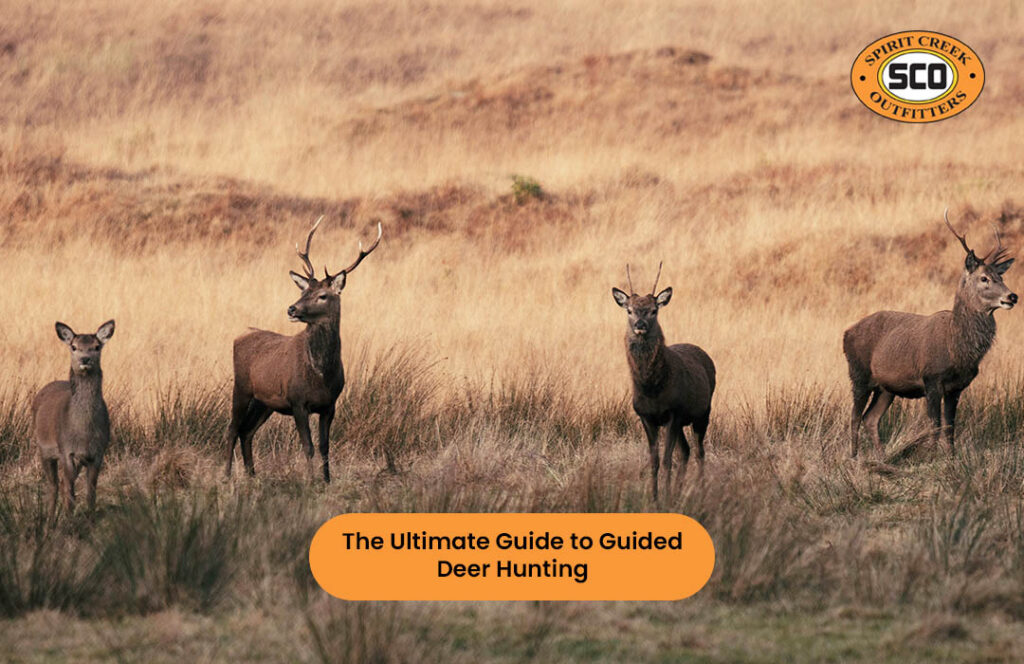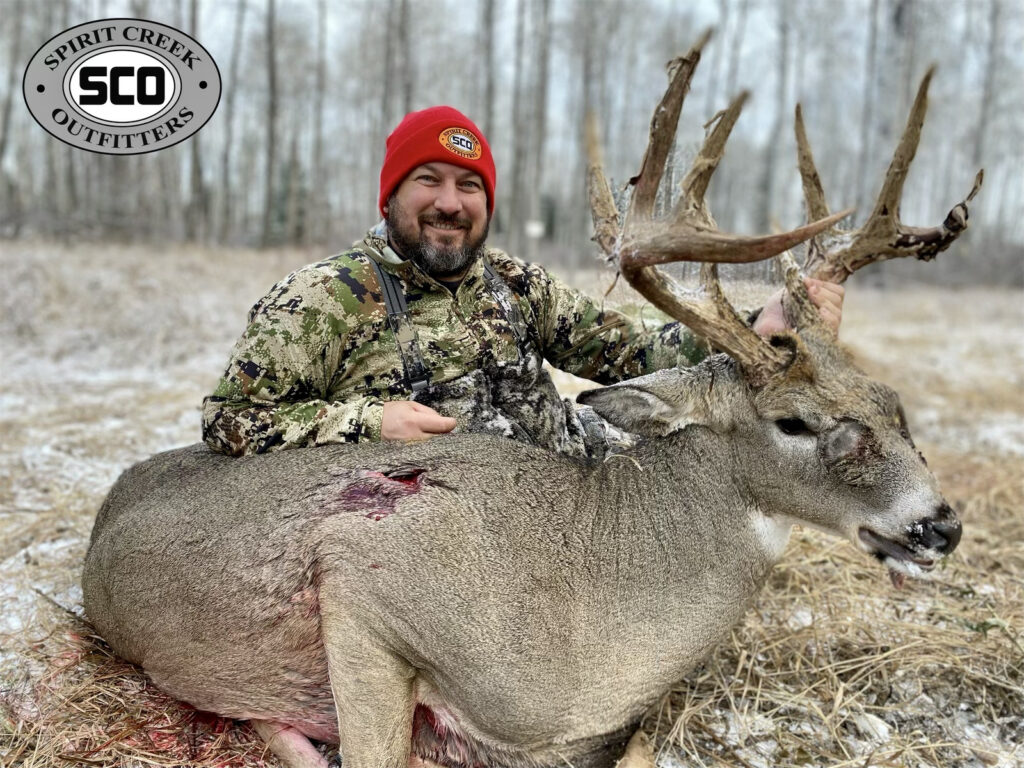Introduction: The Art of Deer Hunting at Spirit Creek Outfitters
At Spirit Creek Outfitters, we believe that deer hunting is more than just a sport; it’s an art. It’s about blending into nature, understanding the behavior of the deer, and using your skills to outsmart them. Here, we don’t just chase after deer. We study them, learn their habits, and move with a purpose. To us, the thrill of the hunt is matched only by the respect we have for the natural world and the creatures that inhabit it. We’ve honed our approach over years, learning that patience, knowledge, and preparation are key. Whether you’re a seasoned hunter or gearing up for your first expedition, we’re here to guide you through every step, sharing insights that can only come from years spent in the wilderness. Stick with us, and you’ll learn not just how to hunt, but how to do so with skill and respect.
Understanding Deer Behavior: The Key to a Successful Hunt
Getting to know how deer live and act is like unlocking a secret formula for your hunting success. Deer are creatures of habit. They follow the same paths, looking for food, water, and a safe place to hang out. When you understand this, you put yourself miles ahead of other hunters. First thing’s first – deer are most active during dawn and dusk. These times, known as twilight hours, are when you’ll likely spot them moving around. But here’s the real secret: weather and seasons play a huge role in their behavior. Deer move around more when it’s cold, searching for food to keep their energy up. Also, during the breeding season, or the rut, bucks throw caution to the wind in search of a mate, making them easier to spot.
Pay attention to these simple yet effective insights:
- Know the signs: Look for tracks, droppings, and bedding areas. These clues tell you a deer was here and might come back.
- Stay quiet: Deer have sharp ears. The slightest sound can spook them. Move slow, stay silent.
- Be scent-free: Deer can smell you from afar. Use scent blockers or play the wind to your advantage.
By understanding deer behavior, you tailor your approach, making your time in the woods more productive. It’s not about luck; it’s about strategy. Remember, knowing your target makes you a better hunter.
Essential Gear for Deer Hunting: What You Need to Know
Before you head out into the wild chasing that trophy buck, let’s talk gear. First things first, a reliable rifle or bow is non-negotiable. It’s your main tool, so choose wisely based on what you’re comfortable with and the hunting regulations in your area. Next up, a good quality camouflage. Deer aren’t blind; you need to blend in with your surroundings to get close. Don’t skimp on a decent pair of boots, either. You’ll be trekking through all sorts of terrain, so comfort and durability are key. Now, let’s not forget about scent control. Deer have keen noses, and if they catch even a hint of you, they’re gone. Use scent-eliminating sprays or wear scent-control clothing. Lastly, a durable, lightweight pack to carry your essentials — water, snacks, a first aid kit, and extra ammo or arrows. Remember, it’s not just about what you carry, but how you use it. Be prepared, stay patient, and keep sharp. Happy hunting.
The Best Times and Seasons for Deer Hunting
Knowing when to head out into the woods can make or break your deer hunting experience. Deer, like many animals, follow natural patterns that can clue hunters in on the best times to find them. Generally, the early morning hours just after dawn and the late afternoon hours before dusk are golden for deer hunters. Deer are most active during these times, foraging for food. So, gear up and be ready in your stand or blind before the sun paints the sky with its first light.
As for the seasons, autumn is prime time for deer hunting. Not only is the weather cooler and more comfortable for both hunter and deer, but it’s also when most states set their hunting seasons. This timing aligns with the deer’s mating season, known as the rut, which peaks in November. During the rut, deer are more active, and bucks are less cautious, making them easier targets for skilled hunters.
Remember, success in deer hunting doesn’t just come from showing up. It requires patience, understanding deer habits, and choosing the right times and seasons to hunt. Keep these tips in mind, and you’ll increase your chances of a rewarding hunting experience.
Location, Location, Location: Finding the Perfect Hunting Spot
Finding the perfect hunting spot is like hitting the bullseye without taking the shot. It’s all about knowing where to look. Here’s the deal: deer, especially big bucks, love areas with plenty of food, water, and cover. Think of places with dense forests near water sources, as they tend to attract deer. Edges are your friend. Where thick brush meets open fields or woods meet grasslands, deer often hang out because they can easily feed and then dash back into cover if they sense danger. Don’t forget to check for tracks, droppings, and bedding areas; these are dead giveaways that deer frequent the area. Looking for rubs on trees and ground scrapes? These are signs of male deer and a good indicator you’re in a hot spot during the rut. Remember, it’s not just about finding deer; it’s about finding the right spot within their habitat where you can remain hidden and have a clear shot. So, put on your walking boots, do some scouting, and patience will pay off. Happy hunting!
Techniques and Strategies: Insights from the Experts
When it comes to deer hunting, there’s a lot more to it than just walking into the woods and hoping for the best. Experts from Spirit Creek Outfitters shared insights that might just make your next hunting trip a success. First up, know your deer. Understanding deer behavior and movement patterns is crucial. Deer are at their peak activity during the early morning and evening hours so timing your hunt during these hours increases your chances. Scout the area before hunting season. Search for indications of deer presence, such as footprints, excrement, and resting spots.”This will give you a good idea of where to set up. Position yourself downwind of the direction from which you anticipate the deer to approach. Deer possess an extraordinary sense of smell, and they will quickly flee at the slightest whiff of your scent. Therefore, maintaining silence is crucial. Any unnatural sound can startle deer. Move slowly and quietly, being mindful of where you step. Patience pays off. Sometimes, you may need to stay in your spot for hours. Deer don’t follow a schedule, and waiting quietly is often the key to success. Remember, it’s not just about the hunt, but enjoying the entire experience. Keep these strategies in mind, and you’re already on a better path to a successful deer hunting adventure.
Tracking and Spotting: How to Read Deer Signs
When you’re in the woods looking for that big buck, your ability to read deer signs can make or break your hunt. First off, look for tracks. Deer tracks are distinctive with their two-toe shape. A bigger print often means a bigger deer. Next, watch out for droppings. Deer poop gives clues about when the deer passed by and how frequently the area is visited. Now, don’t forget rubs on trees. Bucks rub their antlers against the bark, stripping it away. This sign is a billboard saying, “I’m here, come find me.” Lastly, spotting a scrape is like finding gold. Bucks scrape the ground to mark their territory and attract does. These signs are freshest in the early morning or late evening. To sum it up, keep your eyes peeled for tracks, droppings, rubs, and scrapes. Mastering the art of reading these signs will set you on the path to successful deer hunting. Happy hunting!
Shot Placement: Maximizing Your Success Rate
Nailing the perfect shot is crucial in deer hunting. Aim for the vital areas – think heart and lungs. Hitting these spots ensures a quick and ethical take down. Broadside or slightly quartering-away angles are your best bets. These positions expose the deer’s vital organs, giving you a clear shot. Remember, patience pays. Wait for the right moment when the deer is calm and unaware of your presence. Rushing can lead to missed shots or worse, injuring the animal. Accuracy over distance, always. It’s better to be confident and close, than uncertain and far. Get familiar with your weapon, whether it’s a bow or rifle, and practice year-round. The goal is a successful hunt with respect for the animal. Aim true, hunt ethically.
Safety and Ethics: Responsible Hunting Practices
When you’re out in the field, hunting is more than just tracking and taking down a deer. It’s about respecting the wilderness and ensuring you’re hunting safely and ethically. Always prioritize safety, both for you and fellow hunters. Wearing bright orange gear makes you visible and prevents accidents. Also, always handle your firearm with care. Know where it’s pointed and ensure it’s unloaded until you’re ready to use it.
Ethics play a big role too. Only take shots you’re confident will be humane and quick. It’s about respect for the animal. Make sure of your target and what’s beyond it. Follow local hunting laws and limits to help maintain healthy deer populations. Remember, hunting isn’t just about the thrill; it’s about conservation and respecting nature’s balance.
Lastly, think about your actions’ impact. Report any poaching and commit to leaving no trace in the environment. By hunting responsibly, you honor the tradition and guarantee its enjoyment by future generations. So, gear up, but remember, safety and ethics are your top priorities out there.
Wrap-Up: Putting It All Together for Your Next Hunt
After going through all the tips, it’s about bringing everything together for your next deer hunt. Remember, knowing the deer’s behaviour is crucial. Think like the deer. Early morning or late afternoon? That’s your best shot for activity. Don’t forget about scent control. Deer have a keen sense of smell, and you’ll want to blend in, not stand out. And about those calls and lures? Use them wisely. Too much can spook a deer, too little, and you might not catch their attention. It’s all about balance. Your gear matters, from your choice of weapon to the camouflage that keeps you hidden. Lastly, patience and persistence often tip the scales in your favour. Sometimes the difference between going home empty-handed or with a trophy is just a few more minutes of waiting in silence. So take these insights, refine them with your own experiences, and make your next hunt the best one yet. Happy hunting!


